
95% of researchers rate our articles as excellent or good
Learn more about the work of our research integrity team to safeguard the quality of each article we publish.
Find out more
REVIEW article
Front. Earth Sci. , 09 January 2023
Sec. Economic Geology
Volume 10 - 2022 | https://doi.org/10.3389/feart.2022.1034341
This article is part of the Research Topic Exploration, Exploitation, and Utilization of Coal-Measure Gas into the Future View all 16 articles
The research of methane adsorption on tectonic coal is an important content to gas disaster prevention and coalbed methane (CBM) exploration in outburst coal seams. Many projects of methane adsorption capacity and behavior of tectonic coal, such as adsorption difference between tectonic coal and its untectonic coal, adsorption evaluation of tectonic coal, factors for adsorption capacity of tectonic coal, gas-solid coupling feature in tectonic coal and supercritical adsorption phenomena of tectonic coal, were carried out by scientists. Combined with a long-term study on organic matter structure and methane adsorption of tectonic coal, the author summarized recent-years’ researches on adsorption capacity and behavior of tectonic coal-methane at home and abroad from the dispute of adsorption ability determination, the thermodynamic characterization of methane adsorption capacity, and the methane adsorption behavior of quantum chemical calculation of the adsorption and the gas content calculation based on loss compensation, respectively. It is believed that the coal structure controls the methane adsorption capacity and behavior characteristics of different tectonic coals, and from the perspective of thermodynamics, the adsorption capacity of different types of coals can be better distinguished. In the future, a more scientific and complete quantum chemical calculation of methane adsorption by tectonic coal and a compensation method based on instantaneous emission loss should be established, so as to better reveal the methane adsorption behavior of tectonic coal and the mechanism of coal and gas outburst. The research has a reference to fine research of coal adsorption and CBM exploration practices.
The theoretical research and engineering practice of gas geology attach great importance to the research on tectonic coal (Aguado and Nicieza, 2007; Wold et al., 2007; Jiang et al., 2009; Yan et al., 2013; Zhang et al., 2021; Lin et al., 2022; Tu et al., 2022): On the one hand, coal and gas outburst is the result of the combination of tectonic coal, gas and tectonic actio. The “Regulations on Prevention and Control of Coal and Gas Outbursts” formulated by the State Administration of Work Safety of China even has listed tectonic coal as the first index for predicting the risk of coal seam outbursts; on the other hand, the low strength, low permeability and complex gas-solid coupling relationship of tectonic coal make coalbed methane (CBM) extraction more difficult. For example, the gas geology community often takes the prediction of tectonic coal as the basis for predicting coal and gas outburst, and discusses why tectonic coal has the risk of outburst from the aspects of coal structure and mechanical properties (Cao et al., 2003); when drilling a seam with developing tectonic coal, the instantaneous gas emission is large, making it difficult to accurately measure the gas content, which in turn affects the accuracy of gas emission prediction seriously. Perhaps it was because of the existence of tectonic coal, an associated “product” that shared the same parent material with normal coal (in this paper, the “untectonic coal” which is not affected by structural deformation is used to represent “normal coal”), when predecessors studied the characteristics of gas adsorption of coal, they paid special attention to the gas adsorption of different types of destruction coals (different types of tectonic coals). Ju et al. (2004) divided tectonic coal into three deformation sequences: brittle deformation, brittle-ductile and ductile deformation according to the tectonic deformation mechanism system. Jiang et al. (2016) considered that the brittle series of tectonic coal, cataclastic coal, mortar coal, granulitic coal and schistose coal were favorable target layers for CBM development, while Mylonitic coal of ductile deformation was considered to be a high-incidence area of coal and gas outbursts. The special pore and fissure structure of tectonic coal determined the coalbed methane (gas) adsorption capacity and behavior characteristics different from that of untectonic coal, and generally believed that the characteristics of structural fragmentation, large specific surface area and large molecular gap made tectonic coals have stronger adsorption capacity for methane (Qu et al., 2015). However, there are also reports that there is no significant difference in methane adsorption capacity between tectonic coal and co-existing untectonic coal, or the increase in the degree of damage does not improve the methane adsorption capacity of coal (Wang et al., 1993; Dong., 2019).
At present, researchers mostly use experimental methods to study the gas adsorption capacity and behavior characteristics of coal. The experimental method is to reflect the adsorption characteristics of coal samples from a macro perspective, the control variates method is often used to study the influence of a certain factor (such as temperature, pressure, etc.) on the gas adsorption capacity of coal, and the single-layer adsorption model (Langmuir adsorption model) and the multi-layer adsorption model (BET model) are mainly used for calculation. Scholars have done a lot of experimental research on the methane adsorption characteristics of tectonic coal. Zhang et al. (2007) and Jiang et al. (2009) believed that in the process of tectonic coal deformation, in addition to the evolution of chemical structure and coal macromolecular structure to order and high aromatization, many low molecular compounds and gaseous hydrocarbons (gas) were produced, which further improved the gas-bearing performance of the tectonic coal distribution area. Ju et al. (2008) carried out isothermal adsorption and desorption experiments on untectonic coal and tectonic coal under equilibrium water conditions, and found that due to differences in pore structure and chemical structure, the adsorption and desorption mechanism of tectonic coal was different from that of untectonic structural coal. Pan et al. (2012) believed that the adsorption of coalbed methane was related to the deformation structure of tectonic coal at different temperatures and pressures, and the methane adsorption of coal decreased with the increase of temperature. At a certain temperature, the adsorption of methane by different structural deformed coals was also different. For example, at a constant temperature of 30°C, the adsorption capacity of strong brittle-ductile deformed coal was significantly higher than that of weakly brittle deformed coal and strong brittle deformed coal; under low pressure conditions, the adsorption capacity of strong brittle deformed coal was significantly higher than that of weakly brittle deformed coal; however, with the increase of pressure, the adsorption capacities of the two coals tended to be the same. Cheng and Pan, 2020 found that the Langmuir volume and Langmuir pressure of tectonic and untectonic coals showed a “U" shape relationship with the degree of metamorphism. It was believed that the affinity between methane and tectonic coal was stronger than that of untectonic coal, so tectonic coal had stronger methane adsorption capacity.
The most fundamental factor affecting the macroscopic experimental results of the gas adsorption capacity and behavior of tectonic coal is the change of its microstructure. Therefore, it is difficult to explore the adsorption characteristics of gas in tectonic coal from the mechanism only by means of experimental methods, and molecular simulation can be used to analyze the adsorption mechanism of gas molecules in coal reservoirs from the molecular level at the microscopic scale. Thus, in recent years, molecular dynamics simulation has gradually become an important way to solve the complex adsorption behavior of coal. At present, the molecular simulation methods of coal are mainly based on molecular dynamics and molecular mechanics theory, and use molecular dynamics (MD), molecular mechanics (MM), finite element simulation and other molecular simulation and statistical methods to model the molecular structure and pore structure of coal. This allows people to more comprehensively and intuitively understand the structural characteristics of coal, and helps to study the physical and chemical properties of coal through computer means. Wang et al. (2016) used the Monte Carlo simulation method to study the relationship between the surface structure of coal and the amount of methane adsorption based on the advanced evolution structure characteristics of tectonic coal, believing that the methane adsorption capacity of coal per unit mass decreased with the increase of the number of stacking layers of aromatic units, and the existence of defects and oxygen-containing functional groups was not conducive to the adsorption of methane. Han et al. (2017) used quantum chemical calculations and discussed the role of structural defects in anthracite-grade tectonic coals and their effects on macromolecular structure. The results showed that stress could promote the evolution of chemical structure of coal. Song. (2019) constructed a macromolecular structure model of mylonite coal, and a grand canonical monte carlo (GCMC) simulation of methane adsorption was performed. By comparing with the interaction between untectonic coal and methane, the gas adsorption characteristics and microscopic interaction mechanism of mylonitic coal were explained.
A large number of studies have shown that the research on the complex and exclusive characteristics of tectonic coal not only establishes the basic theory of geological body structure and tectonic changes under the action of geotectonic movement, but also plays an important guiding role in engineering practice such as coal seam outburst risk prediction and underground gas drainage in CBM low-permeability enrichment areas (Pan et al., 2012; Li et al., 2019; Zhang et al., 2022). Based on the long-term research and knowledge in structural composition of organic matter in tectonic coal and coal-methane adsorption through the author’s research group (Huan et al., 2015; Zhang et al., 2018; Wang et al., 2021a; Yang et al., 2021), this paper summarizes and prospects the progress made in the study of methane adsorption capacity and behavior of tectonic coal in recent years, hoping to share and communicate, and promote further research on the adsorption of tectonic coal, so as to provide a reference for the prediction and prevention of gas disasters in outburst coal seam and to improve the recovery ratio of coal seam methane.
On the research of methane adsorption capacity of tectonic coal, there are many reports at home and abroad, but the understanding is different. Early research results show that there is no significant difference in the methane adsorption capacity of tectonic coal and untectonic coal (Wang et al., 1993), and the volume of methane adsorption does not increase with the increase of the degree of coal damage; In recent years, relevant research results also show that there is indifference in gas adsorption volume compare with tectonic coal and untectonic coal, while the gas adsorption rate of tectonic coal is higher than that of untectonic coal (Dong, 2018). However, Zhang et al. (2006) pointed out that the methane adsorption capacity of tectonic coal is significantly higher than that of untectonic coal when discussing the controlling factors of coal adsorption capacity; Wang et al. (2012) and Hu et al. (2016) conducted a comparative study on tectonic coal and untectonic coal in Jincheng, Jiaozuo, WuYi, Pingdingshan and other mining areas, concluding that the adsorption limit of tectonic coal is greater than that of untectonic coal on the whole.
In the experimental study of high pressure isothermal adsorption of methane on coal (Figure 1), it has been found that: the supercritical adsorption phenomenon occuring in the high pressure section, in which the adsorption pressure increases and the adsorption capacity decreases (Figure 1A), is quite different from the Ⅰ∼V adsorption isotherms that are generally believed to conform to the Langmuir equation (Figure 1), and the adsorption mechanism is different from that of gases below the critical temperature (Gao. 2011). The experimental results of Ju and Li, 2009 show that the methane adsorption capacity of weakly deformed coal increases with the increase of adsorption pressure, which conforms to the Langmuir equation, while the adsorption isotherms of strong and ductile deformed coal show different types (Figure 2). According to its analysis, desorption occurs when the adsorption pressure reaches a certain level, and the tectonic coal is compressed and deformed during the process, causing the deformation of its macromolecules and pore structure, and forming thin bottleneck pores; with the increase of adsorption pressure, the pores gradually closes, resulting in the decrease of adsorption heat and the desorption behavior, which leads to the decrease of methane adsorption capacity.

FIGURE 1. Type of adsorption isotherm: (A) Adsorption isotherm of methane and coal under critical temperature, (I∼V) Adsorption isotherms of the Langmuir equation under critical temperature (modified from Gao., 2011).
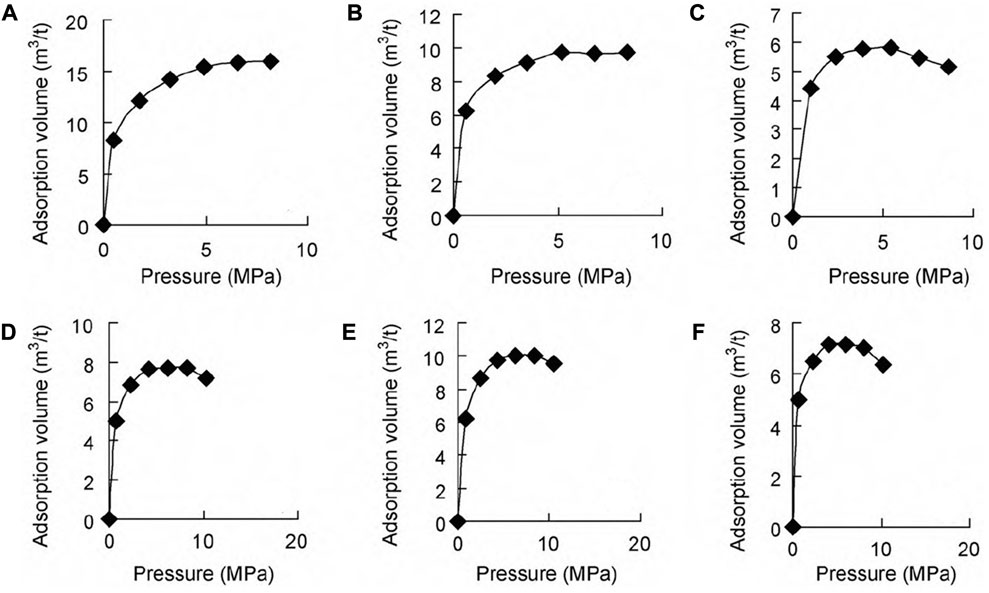
FIGURE 2. Isothermal adsorption curves of tectonic coals and untectonic coal. (A) Untectonic coal; (B) cataclastic structure coal; (C) schistose structure coal in brittle deformation coals; (D) schistose-wrinkle structure coal in brittle-ductile superimposed coals; (E) scaled structure coal in brittle-ductile deformation coals; (F) mylonitic structure coal in ductile deformation coals. (Ju and Li, 2009, reprinted with permission of the copyright holders).
In view of the different understandings of the adsorption capacity of different types of tectonic coals and untectonic coal, and the factors affecting the capacity of methane adsorbed by coal are vast and complex, it is obviously meaningless to find out the strong and weak relationship between the methane adsorption capacity of different types of tectonic coals and co-existing untectonic coal only by discussing the difference in adsorption amount. Under normal formation conditions, CH4 and N2 in coal with extremely low critical temperature are supercritical gas, and CO2 in coal will also be in supercritical state with the increase of burial depth. Apparently, the author suggests it is necessary to start from the perspective of studying the difference in methane adsorption energy between different types of tectonic coals and symbiotic untectonic coal, combine with the research idea of gas supercritical adsorption, and determine which coal of different structure types has a stronger or weaker adsorption capacity for methane through experimental analysis and theoretical estimation, the coal seam gas content is also calibrated accordingly. Jian et al. (2014), Wang et al. (2016) and Song et al. (2017), have carried out a lot of research in this area, and the progress is slow at present, but it does not affect the theoretical value of the problem exploration and the engineering application value of the development of high-performance coal-based methane storage materials with tectonic coal as precursor (Zhang et al., 2017).
As mentioned above, people have different opinions on whether the methane adsorption capacity of different types of tectonic coals must be greater than that of symbiotic untectonic coal. It is a new idea to use adsorption energy to examine the adsorption capacity of coal of different damage types. Since there is no method to directly test the adsorption energy of coal-methane, the adsorption heat can be used instead of the adsorption energy. The basic process of adsorption heat index characterization is: based on the adsorption isotherm experiment, the real adsorption capacity, that is, the absolute adsorption capacity, is calculated with the help of the adsorption model, and the adsorption heat index and the thermodynamic effect of coal-methane adsorption are combined to calibrate the adsorption capacity of tectonic coal for methane. Two common adsorption heats, limit adsorption heat and isosteric adsorption heat, can be calculated from adsorption isotherms. Among them, limit adsorption heat is the effect of adsorption heat when the adsorption amount tends to zero, and is often used as a representative value of heat of adsorption; isosteric adsorption heat is a fractional amount, that is, the thermal effect generated by the increase in the amount of adsorption during the adsorption process.
This research group has carried out the isotherm adsorption experiment of methane on fat coal rank tectonic coal and co-existing untectonic coal from low temperature to room temperature, and has obtained a series of supercritical adsorption isotherms of methane on tectonic coal at 263–303 K, showing supercritical adsorption characteristics, namely: the methane adsorption capacity of both tectonic coal and untectonic coal increases with the increase of equilibrium pressure (Figure 3), and the adsorption curve decreases when the equilibrium pressure reaches a certain value, indicating that the adsorption capacity has a maximum value; the adsorption curve is type I before the maximum appears (Figure 1), and the pressure point at which the maximum appears lags with increasing temperature (Wei., 2012). The adsorption capacity measured by the volumetric method above is the excess adsorption capacity, not the real adsorption capacity of coal to methane, that is, the absolute adsorption capacity, and cannot objectively describe the adsorption of coal reservoirs. Therefore, before calculating the heat of adsorption, in order to explore the methane adsorption characteristics of tectonic coal, it is necessary to establish an absolute adsorption capacity calculation model and obtain the absolute adsorption capacity curve of methane adsorption of tectonic coal according to the experimental data (Zhou and Zhou, 1998; Wei., 2012). As shown in (Figure 4), the absolute adsorption curve no longer has a maximum point, before reaching the adsorption equilibrium, the adsorption amount increases with the increase of pressure. It belongs to the I-type isotherm adsorption curve and obeys the Langmuir equation. The absolute adsorption amount is the real value of coal seam adsorption of methane, which has important guiding significance for accurately predicting coal and gas outburst.
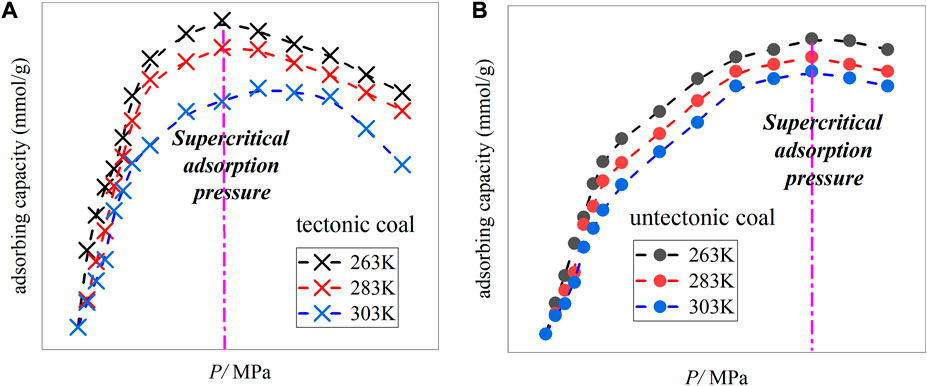
FIGURE 3. Diagram of supercritical adsorption isotherm at 263–303 K fat coal rank tectonic/untectonic coal. (A) tectonic coal; (B) untectonic coal (modified from Wei., 2012).
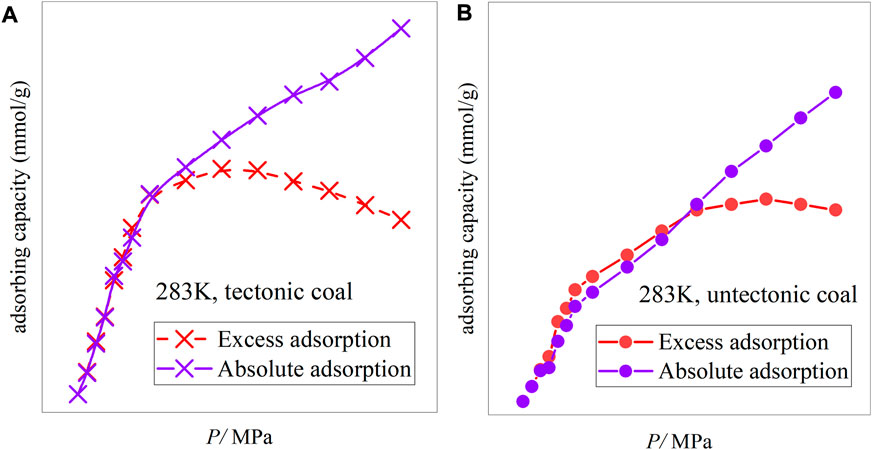
FIGURE 4. Diagram of excess methane adsorption and absolute adsorption isotherms of fat coal rank tectonic/untectonic coal. (A) tectonic coal; (B) untectonic coal (modified from Wei., 2012).
The coal surface is the main place for the adsorption/desorption of coalbed methane. When the adsorption of methane and coal occurs, the coal surface tension will decrease (surface thermodynamics), so the change of coal surface tension in the process of coal-methane adsorption can be calculated by the Gibbs formula. Different from the aforementioned adsorption heat studies, in order to further investigate “whether the methane adsorption capacity of tectonic coal is stronger than that of symbiotic untectonic coal” from the perspective of the surface energy drop of coal adsorbing methane, we used the IS-100 isothermal adsorption/desorption instrument from Terra Tek, United States. The isothermal adsorption experiment of methane with tectonic/untectonic coal with 293, 303, and 313 K coal ranks being coking coal was carried out (Figure 5), and the maximum adsorption equilibrium pressure was 8 MPa (Jian et al., 2014). The results show that: the process of coal adsorption of methane is a process of coal surface energy reduction (Table 1), the overall performance of the experimental coal samples is that the surface energy reduction of tectonic coal adsorbing methane is greater than that of co-existing untectonic coal, both the increase in temperature and the increase in equilibrium pressure make the surface energy drop value of the tectonic coal larger than that of the co-produced untectonic coal (Figure 6). Berkheim has pointed out that “the expansion deformation of solid is proportional to its surface energy drop,” and combined with the surface energy drop of coal adsorbing methane and theoretical calculations, it is believed that adsorption deformation can promote layer slip and dislocation of coal. Obviously, the surface energy reduction of tectonic coal adsorbing methane is greater than that of co-existing untectonic coal, but its coal strength is lower, and it is prone to adsorption expansion, deformation and damage, which may be one of the important reasons why tectonic coal is closely related to coal and gas outburst.
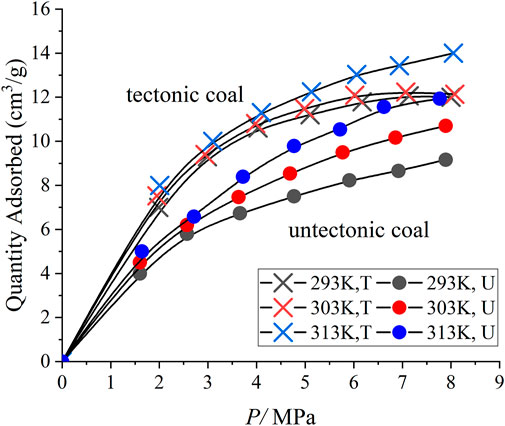
FIGURE 5. Methane adsorption curves of tectonic/untectonic coal under different temperatur conditions (modified from Jian et al., 2014)
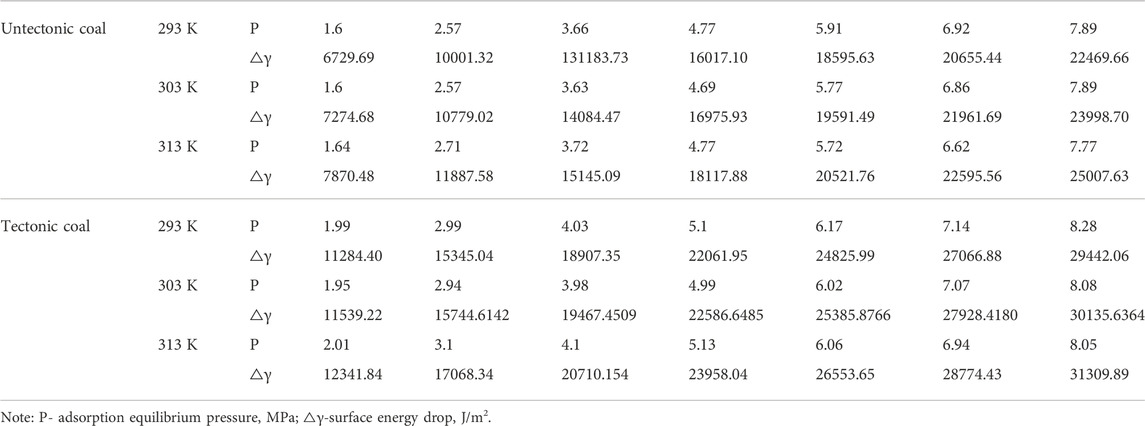
TABLE 1. Statistics of surface energy drop of tectonic/untectonic coal adsorbed methane at different temperatures (modified from Jian et al., 2014).
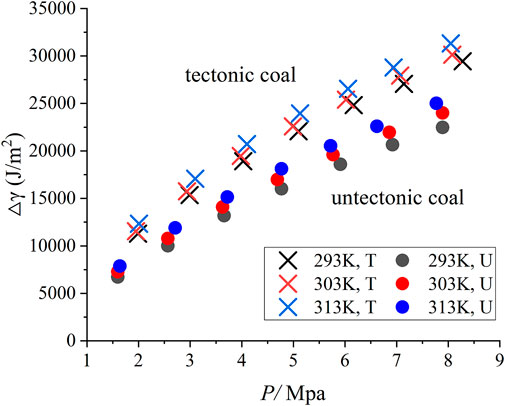
FIGURE 6. The surface energy changed of tectonic/untectonic coal adsorbed methane under different temperatur conditions (modified from Jian et al., 2014)
The high complexity and heterogeneity of coal structure make its adsorption behavior more complicated than that of conventional solid adsorbents (Crawford and Mainwaring, 2001; Wang et al., 2021a; Wang et al., 2021b). Theoretical and experimental studies show that the structure and composition of coal are closely related to the coal organic polymer network structure and the low molecular compounds dispersed in it, which are the intrinsic factors affecting the adsorption/desorption of coalbed methane (Ji et al., 2015; Yang et al., 2021). The quantum chemical calculation of the coal surface can reflect the coal surface properties, and the adsorption and interaction studies of methane molecules on solid surfaces are multi-faceted, so the theoretical calculation of methane adsorption on coal surfaces by quantum chemical methods is more rigorous.
Chen et al. (2000) has modeled atomic clusters on the coal surface and has carried out quantum chemical ab initio calculations with base set (STO-4-31G). The results show that the interaction between methane and the coal surface is anisotropic. When methane overlaps with a regular triangular pyramid on the coal surface, the energy is the lowest, and the maximum adsorption potential is 2.65 kJmo1−1, which belongs to the category of physical adsorption and is manifested as surface condensation. Wang et al. (2008) has proceeded DFT calculation on the mechanism of coal and gas outburst, showing that the adsorption of coal and methane is physical adsorption, and the adsorption energy is 1.16 kJ mo1−1, when the coal-methane adsorption system absorbs electromagnetic waves in the 23–61 cm−1 frequency range, the methane molecules can be desorbed, that is, coal and gas outburst occurs. In this paper, according to the XRD analysis data of co-existing tectonic coal and untectonic coal in the same layer (Table 2), and corresponding to each index in the anthractie coal aromatic ring structure, the untectonic coal and tectonic coal are constructed combined with the unit cell parameters of graphite in the inorganic crystal structure database (ICSD), the models are denoted as M1 and M2 (Jing et al., 2010), respectively (Figure 7). Using the adsorption isotherm calculation task in the sorption module of Materials Studio software, at 298 K and 303 K, the isotherm adsorption curves of untectonic coal (M1), tectonic coal (M2) and methane are calculated respectively (Jing et al., 2010) (Figure 8), shows that the methane adsorption curves of the two models are consistent with Langmuir adsorption characteristics. At 298 K, the saturated adsorption capacity of untectonic coal (M1) is about 28 methane molecules, and that of tectonic coal (M2) is about 50 methane molecules, and the methane adsorption capacity of the tectonic coal is about twice that of the untectonic coal (Figure 8A). At 303 K, the methane adsorption behavior of the tectonic/untectonic coal has the same characteristics as that at 298 K (Figure 8B). Theoretical calculation studies combining quantum chemistry and model intermolecular interactions suggest that: during the formation of tectonic coal, the coal deformation increases, the structure of the side chain on the aromatic core of the coal changes, and the steric hindrance weakens, reducing the rate of methane passing through the coal body. In addition, the side groups and even the polymer main chain are partially broken to form a high free energy center, which is conducive to the diffusion of methane, when the energy of free methane is equal to or higher than the binding energy of the side groups on the aromatic core of coal, methane can naturally penetrate into the side groups of the coal structure, and occupy vacancies (adsorption sites) there, which adsorption behavior reduces the free energy of coal. The adsorption energy of methane on the surface of tectonic coal is greater than that of untectonic coal (Table 3), indicating that tectonic coal can store a larger amount of methane than co-existing untectonic coal (Wang et al., 2009). The study of methane activation and adsorption by coal surface structure is helpful to deeply understand the methane adsorption behavior on coal surface, and reveal the mechanism of coal and gas outburst from the molecular level.

TABLE 2. Ro,max and XRD analysis data of different types of anthractie coal (modified from Jing et al., 2010).
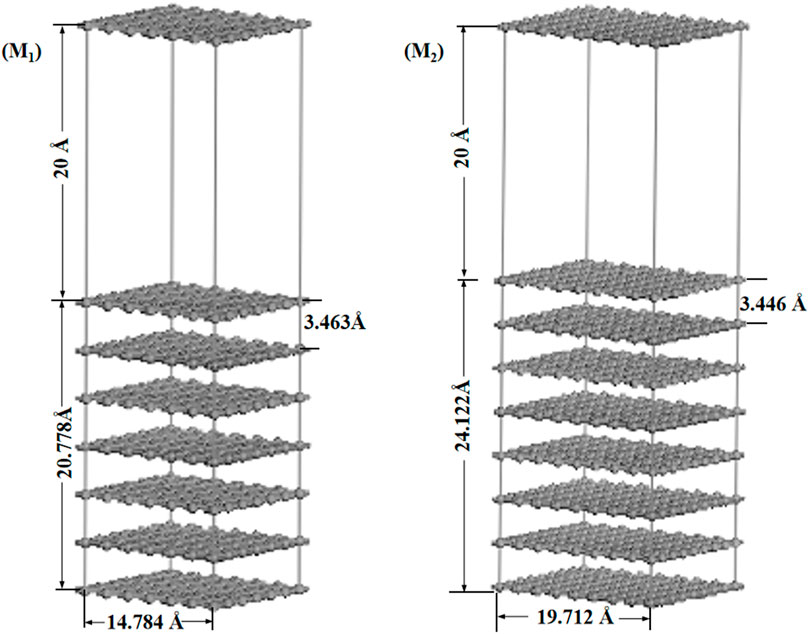
FIGURE 7. Models of untectonic anthractie coal (M1) and anthractie tectonic coal (M2) (modified from Jing et al., 2010).
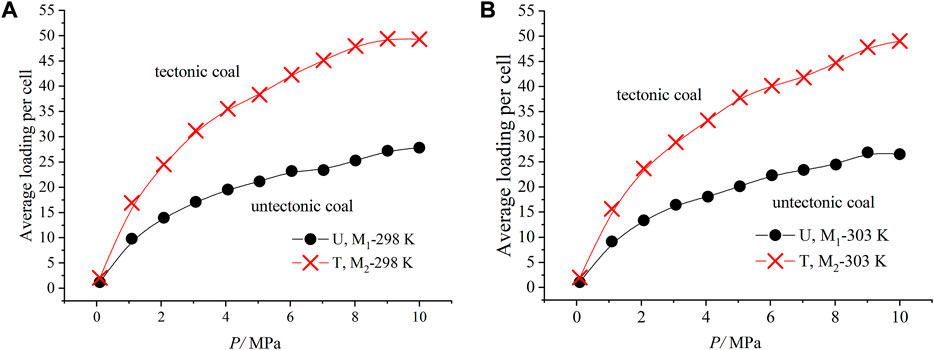
FIGURE 8. CH4 adsorption isotherms of anthractie untectonic coal (M1) and tectonic anthractie coal (M2) at 298 K and 303 K. (A) 298 K; (B) 303 K (modified from Jing et al., 2010).

TABLE 3. Gas and different types of coal adsorption distance, adsorption energy and bond order (modified from Wang et al., 2009).
A large number of on-site tests and survey statistics show that the two tentative indicators for predicting the risk of coal seam outbursts tentatively set in the “Regulations on Prevention and Control of Coal and Gas Outbursts,” the initial velocity of gas emission (ΔP, the critical value is 10 ml s−1) and coal seam gas content (W, the critical value is 8 m3 t−1), almost become insensitive indicators (or the critical value is inappropriate) in the coal seam developed in tectonic coal, which lacks scientificity and reliability, and should attract the attention of researchers. However, in the current engineering practice, the risk of coal seam outburst is still judged accordingly. Most of predecessors have used isothermal adsorption/desorption experiments to explore the gas properties of coal, but the research on the instantaneous emission mechanism of coal and gas is weak, which is the basis for the determination of gas content in tectonic coal and the prediction of coal seam outburst risk (Zhang and Y, 2014). It can be seen that revealing the initial gas desorption law of tectonic coal, finding out the loss quantity in the determination of gas content in tectonic coal-developed coal seams, and establishing a compensation method for the loss quantity have important practical significance for mine gas disaster prediction and coalbed methane resource evaluation.
Based on coal seam gas content, the “Regulations on Prevention and Control of Coal and Gas Outbursts” sets the critical value for predicting regional outburst risk as 8 m3 t−1. However, when the developed coal seam of tectonic coal is drilled, the instantaneous gas emission is large (Figure 9), which makes it difficult to accurately measure the gas content (Fu et al., 2008). It is generally believed that the main reason is: coal seam gas content includes loss, on-site desorption and residual gas, among which the measurement errors of on-site desorption and residual gas are negligible, and the error mainly comes from the calculation of the loss; when drilling a developed coal seam of tectonic coal to measure the gas content, the rapid expansion of the coal micro-cracks makes the relatively closed original cracks and pores communicate and connect, resulting in that the instantaneous gas desorption rate in the coal is great, and the instantaneous amount of escape is large, so accurately calculating the gas loss of tectonic coal is a difficult point in the determination of coal seam gas content.
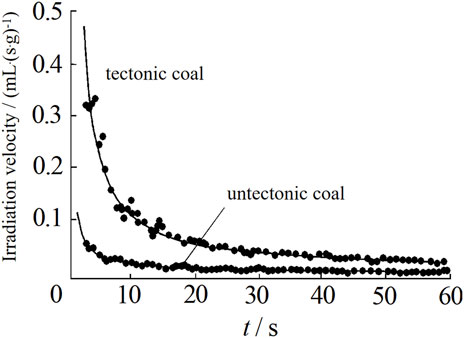
FIGURE 9. Coal sample irradiation velocity curve (modified from Fu et al., 2008).
Domestic and foreign scholars have done a lot of research on the problem of loss compensation in the process of gas content determination (Qi et al., 2007; Liu et al., 2013; Song et al., 2021; Yi et al., 2022). The established empirical/semi-empirical loss calculation formula plays an important role in revealing the gas desorption law and calculating the gas loss, but it also has certain limitations. For example, the error of Barrel’s formula increases with the extension of desorption time; the Venter formula conforms to the law of initial gas desorption, but the error increases with the extension of desorption time; the Bott formula is inconsistent with the initial desorption amount of gas; the exponential formula is the basis for determining the gas content of the coal seam by the underground desorption method of coal mines in China, but when the measured coal seam is of tectonic coal, the calculated gas loss has a large deviation from the actual value. In recent years, China has reported many studies on gas desorption law and gas loss. For example, He (2010) has obtained the influence coefficient of temperature on gas desorption of tectonic coal through regression analysis of gas desorption of tectonic coal at different temperatures η = exp [0.012·(T-10)], and then obtains the calculation formula QT = η·Q10 of gas loss at different temperatures; Li (2010) has investigated the effects of desorption empirical formulas, desorption time and desorption temperature on the gas desorption amount, and consideres that QT(t)= exp [0.011·(T-20)] K·
Based on the relationship between the residual gas volume (WC, ml/g) and gas pressure (P, Mpa), remaining in the Changcun mine’s tectonic coal and co-existing untectonic coal after being exposed for a certain period of time, the research group has established the following content-pressure calculation formula (Xie., 2014):
After on-site inspection, it is considered that the proposed calculation method of gas loss, that is, the method of calculating gas content from residual gas, is accurate and reliable.
The complex structure and heterogeneity of tectonic coal make it difficult to accurately characterize the influence of various factors on its adsorption capacity and behavior, so people are more inclined to use the academic thought “structure-property” to explore its structural relationship. The adsorption properties of coal are not only related to the physical properties such as specific surface area and pore size distribution (Wang et al., 2018), its surface chemical structure/composition also has an important influence on the adsorption behavior. The essence of the difference in the methane adsorption capacity and behavior characteristics of coal with different coal structureis differences in physicochemical structure of coal, which is initiated by different degrees of brittle cracking, crushing or ductile deformation or superimposed failure of primary structure of tectonic coal under the action of one or more periods of tectonic stress.
Xu et al. (2010) observed the surface structure of briquette with different particle sizes, noticing that the smaller the particle size of briquette samples was, the higher the degree of pore development was, and the shear strength decreased with the increase of particle size; adsorption experiments showed that the briquette made of large particle size coal powder had larger porosity, better connectivity and permeability. Li et al. (2003) investigated the pore structure of tectonic coal in China’s Pingdingshan mining area by Mercury intrusion and found that compared with co-existing non-tectonic coal, the porosity of tectonic coal was 3–8 times higher and the specific surface area was 2–10 times higher. Among them, brittle deformed coal had higher porosity, large specific surface area and wider cracks, while ductile deformed coal had supramaximal specific surface area and narrow cracks. The introduction of High Resolution Transmission Electron Microscopy (HRTEM) technology has facilitated the identification of nano-scale pores in coal, which is considered to be the main storage space for coalbed methane (Song et al., 2019; Song et al., 2020). HRTEM results of different types of tectonic coals show: from brittle deformed coal to ductile deformed coal, the cumulative pore volume, total specific surface area and nitrogen adsorption increase rapidly with the increase of deformation degree (Ju et al., 2005). Li et al. (2012) discussed the influence of deformation of different mechanisms on the coal macromolecules-nano-scale pore structure, and established a coupling model of tectonic coal macromolecules-nano-scale pore structure, believing that the change of the macromolecular structure of coal during the formation of tectonic coal is the main reason for the change of the nano-scale pore structure of coal. Our research group has observed the surface morphology of tectonic coal/symbiotic untectonic coal with Scanning Electronic Microscopy (SEM), finding that as shown in Figure 10, micro-pores on the inner surface of tectonic coal are prevalent, and compared with untectonic coal, it has a more complex pore structure (Gao. 2011). It is considered that the change of coal macromolecular structure caused by tectonic extrusion and shearing promotes the development of coal microporous structure, which is the main space for methane adsorption and diffusion. This is consistent with the research on the correlation between the ultrastructure of tectonic coal and chemical/physical coalification carried out by Ju and Li, 2009.
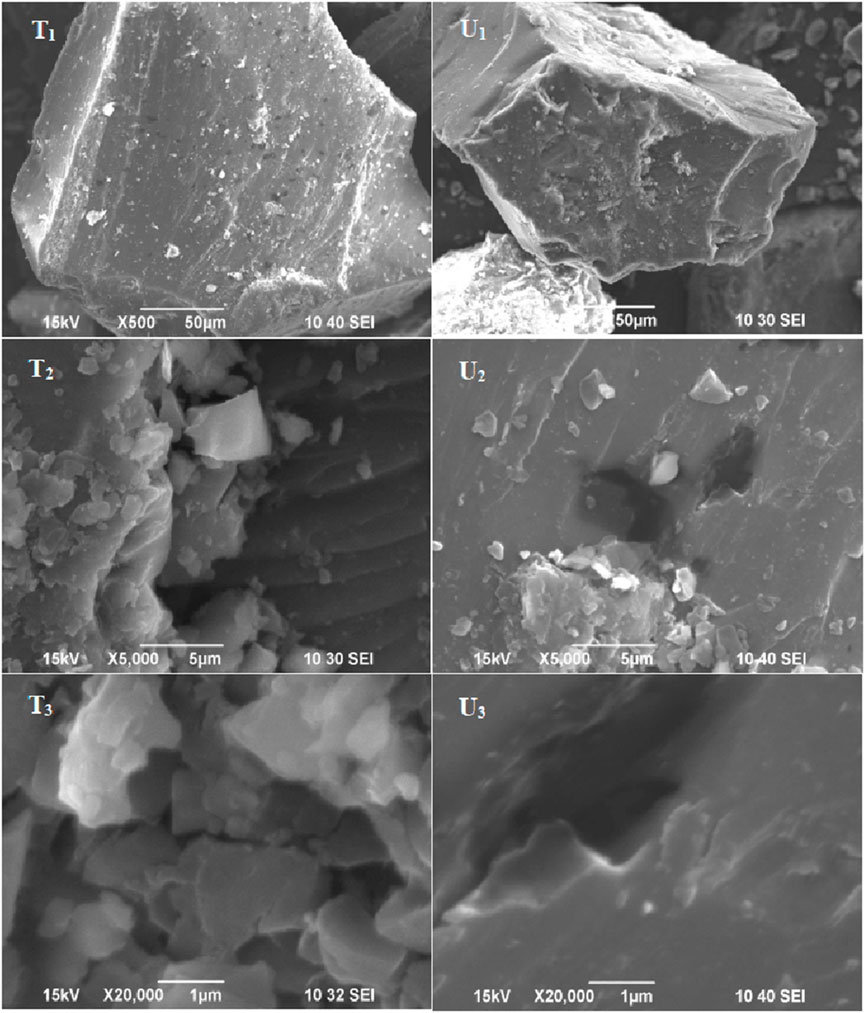
FIGURE 10. SEM images comparing morphological features of fat coal rank tectonic/untectonic coal (modified from Gao., 2011). Note: T1, T2, and T3 are tectonic coal samples; U1, U2, and U3 are untectonic coal samples.
Adsorption will occur on the new surface generated by the deformation and rupture of the coal, combining the genesis and physical properties of tectonic coal, our research group believes that adsorption is involved in the formation process of tectonic coal (Zhang and Y, 2014). It is expressed as: during the formation of tectonic coal, the structure of coal is broken and pulverized, increasing the pore space and inner surface area of coal, and providing more space for methane accumulation; the gas adsorption causes the expansion and deformation of the coal rock, which generates the change of the pore structure of the coal rock. Methane in coal is mainly in the adsorbed state, and compared with the symbiotic untectonic coal, the microstructure characteristics of tectonic coal show: on the one hand, the development of micro-cracks and pore structures in tectonic coal provides space for gas accumulation, which may increase the gas storage capacity of coal (Qu, 2011); on the other hand, the tectonic coal structure evolves in advance (Figure 11), and the aromatic layers of coal nuclei are stacked vertically and stretched horizontally (Figure 12), which may enhance the adsorption capacity of coal (Zhang et al., 2016), and the difference in adsorption capacity of methane should be one of the reasons for the prominent danger of tectonic coal. In addition, in terms of nature that making tectonic coal prone to trigger coal and gas outbursts, adsorption behavior aggravates the fragmentation of the coal structure, and while reducing the coal strength, new pore spaces and inner surfaces may be formed to accumulate more gas; the coal shrinkage after gas discharge can cause pressure relief. The uneven distribution of gas in the coal seam will cause uneven distribution of stress, and the release of adsorption behavior will constitute a potential driving force for starting and promoting coal and gas outbursts.
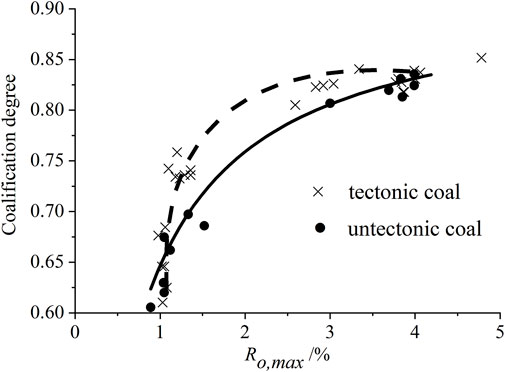
FIGURE 11. Relationship between coalification degree and average maximum reflectance of vitrinite (Ro,max) of different types coal (modified from Zhang et al., 2016).

FIGURE 12. Growth characteristics of microcrystalline structure of tectonic coal and untectonic coal: (A) Relation between Lc and Ro,max, (B) Relation between La/Lc and Ro,max (modified from Zhang et al., 2016).
The research on the methane adsorption capacity and behavior characteristics of tectonic coal is of great significance to the production practice activities, such as coalbed methane resource exploration (energy development) and mine gas outburst (safety mining). Combing with the author’s long-term exploration and practice in the study of structural composition of tectonic coal and structure relationship of coal-methane adsorption, in this paper, the author summarized recent-years’ researches on adsorption capacity and behavior of tectonic coal-methane at home and abroad from the dispute of adsorption ability determination, the thermodynamic characterization of methane adsorption capacity, and the methane adsorption behavior of quantum chemical calculation of the adsorption and the gas content calculation based on loss compensation, respectively. It is believed that the coal structure controls the methane adsorption capacity and behavior characteristics of different tectonic coals, and from the perspective of thermodynamics, the adsorption capacity of different types of coals can be better distinguished. In the future, a more scientific and complete quantum chemical calculation of methane adsorption by tectonic coal and a compensation method based on instantaneous emission loss should be established, so as to better reveal the methane adsorption behavior of tectonic coal and the mechanism of coal and gas outburst. It is hoped that we can share and communicate, and promote further research on the adsorption of tectonic coal, so as to provide scientific reference for the prevention and control of outburst coal seam gas disasters and the improvement of coalbed methane recovery.
HZ: data curation, formal analysis, writing—original draft. XZ: conceptualization, data curation, supervision. YZ: conceptualization, funding acquisition, supervision. ZW: supervision.
This work was supported by the National Science and Technology Major Projects of China (No. 2016ZX05067006).
The authors declare that the research was conducted in the absence of any commercial or financial relationships that could be construed as a potential conflict of interest.
All claims expressed in this article are solely those of the authors and do not necessarily represent those of their affiliated organizations, or those of the publisher, the editors and the reviewers. Any product that may be evaluated in this article, or claim that may be made by its manufacturer, is not guaranteed or endorsed by the publisher.
Aguado, M. B. D., and Nicieza, C. G. (2007). Control and prevention of gas outbursts in coal mines, Riosa-Olloniego coalfield, Spain. Int. J. Coal Geol. 69, 253–266. doi:10.1016/j.coal.2006.05.004
Cao, Y. X., Davis, A., Liu, R., Liu, X. W., and Zhang, Y. G. (2003). The influence of tectonic deformation on some geochemical properties of coals—A possible indicator of outburst potential. Int. J. Coal Geol. 53, 69–79. doi:10.1016/S0166-5162(02)00077-0
Chen, C. G., Wei, X. W., and Xian, X. F. (2000). AB intio study on the interaction between CH4 and the coal surface. J. chongqing Univ. Sci. Ed. 23, 77–80. doi:10.3969/j.issn.1000-582X.2000.03.021
Cheng, Y. P., and Pan, Z. J. (2020). Reservoir properties of Chinese tectonic coal: A review. Fuel 260, 116350. doi:10.1016/j.fuel.2019.116350
Crawford, R. J., and Mainwaring, D. E. (2001). The influence of surfactant adsorption on the surface characterisation of Australian coals. Fuel 80, 313–320. doi:10.1016/S0016-2361(00)00110-1
Dong, J. (2019). Gas diffusion properties of coal mass based on equivalent physical structure and its application. PHD thesis. CHINA: China University of Mining and Technology.
Fu, X., Wang, K. J., and Yang, T. H. (2008). Gas irradiation feature of tectonic coa. J. China Coal Soc. 33, 775–779. doi:10.3321/j.issn:0253-9993.2008.07.011
Gao, F. (2011). Study on the microstructure and methane adsorption of deformed coal. Master's thesis. CHINA: Henan Polytechnic University.
Han, Y. Z., Wang, J., Dong, Y. J., Hou, Q. L., and Pan, J. N. (2017). The role of structure defects in the deformation of anthracite and their influence on the macromolecular structure. Fuel 206, 1–9. doi:10.1016/j.fuel.2017.05.085
He, Z. G. (2010). Study on the effect of temperature on the desorption law of tectonic coal gas. Master's thesis. China: Henan Polytechnic University.
Hu, P. H., Shao, S. Y., Sun, Y. F., and Dong, L. H. (2016). Study on emission and adsorption characteristics of tectonic coal and original-structure coal. China Min. Mag. 25, 156–163. doi:10.3969/j.issn.1004-4051.2016.04.033
Huan, X., Zhang, X. B., and Wei, H. W. (2015). Research on parameters of adsorption potential via methane adsorption of different types of coal. J. China Coal Soc. 40, 1859–1864. doi:10.13225/j.cnki.jccs.2014.1220
Ji, H. J., Li, Z. H., Peng, Y. J., Yang, Y. L., and Zhou, Y. B. (2015). Analysis of extracts and effects of them on methane adsorption characteristics of coal. J. China Coal Soc. 40, 856–862. doi:10.13225/j.cnki.jccs.2014.3021
Jian, K., Zhang, Y. G., He, S. P., and Gao, C. R. (2014). The surface energy of methane adsorption of tectonic coal. Coal Geol. Explor. 42, 31–34. doi:10.3969/j.issn.1001-1986.2014.01.007
Jiang, B., Li, M., Qu, Z. H., Liu, J. G., and Li, W. (2016). Current research status and prospect of tectonically deformed coal. Adv. Earth Sci. 31, 335–346. doi:10.11867/j.issn.1001-8166.2016.04.0335
Jiang, B., Qin, Y., Ju, Y. W., Wang, J. L., and Li, M. (2009). The coupling mechanism of the evolution of chemical structure with the characteristics of gas of tectonic coals. Earth Sci. Front. 16, 262–271. doi:10.1016/S1003-6326(09)60084-4
Jing, W. (2010). Molecular simulation of adsorption and diffusion of methane in deformed coal. China Taiyuan Polytechnic University. Master’ thesis.
Ju, Y. W., Jiang, B., Hou, Q. L., and Wang, G. L. (2004). The new structure-genetic classification system in tectonically deformed coals and its geological significance. J. China Coal Soc. 5, 513–517. doi:10.3325/j.cnki.Jccs.2004.05.001
Ju, Y. W., Jiang, B., Hou, Q. L., Wang, G. L., and Fang, A. (2005). Structural evolution of nano-scale pores of tectonic coals in Southern North China and its mechanism. Acta Geol. Sin. 79, 269–285. doi:10.3321/j.issn:0001-5717.2005.02.013
Ju, Y. W., Jiang, B., Hou, Q. L., Tan, Y. J., Wang, G. L., and Xiao, W. J. (2008). Behavior and mechanism of the adsorption/desorption of tectonically deformed coals. Chin. Sci. Bull. 54, 88–94. doi:10.1007/s11434-008-0412-4
Ju, Y. W., and Li, X. S. (2009). New research progress on the ultrastructure of tectonically deformed coals. Prog. Nat. Sci. 19, 1455–1466. doi:10.1016/j.pnsc.2009.03.013
Li, H. (2010). Experimental study on the effect of ambient temperature on the gas desorption law of granular coal. Master's thesis. China: Henan Polytechnic University.
Li, H. Y., Ogawa, Y., and Shimada, S. (2003). Mechanism of methane flow through sheared coals and its role on methane recovery. Fuel 82, 1271–1279. doi:10.1016/S0016-2361(03)00020-6
Li, X. S., Ju, Y. W., Hou, Q. L., and Lin, H. (2012). Spectra response from macromolecular structure evolution of tectonically deformed coal of different deformation mechanisms. Sci. China Earth Sci. 55, 1269–1279. doi:10.1007/s11430-012-4399-y
Li, Y. B., Zhang, Y. G., Zhang, Z. M., and Jiang, B. (2013). Experimental study on gas desorption of tectonic coal at initial stage. J. China Coal Soc. 38, 16–20. doi:10.13225/j.cnki.jccs.2013.01.017
Li, W., Jiang, B., and Zhu, Y. M. (2019). Impact of tectonic deformation on coal methane adsorption capacity. Adsorpt. Sci. Technol. 37, 698–708. doi:10.1177/0263617419878541
Lin, J., Cheng, Y. P., Ren, T., Liu, Q. Q., and Tu, Q. Y. (2022). New insights into failure behaviors of tectonic coal under triaxial conditions using reconstituted coal specimens. Rock Mech. Rock Eng. 55, 1361–1374. doi:10.1007/s00603-021-02715-5
Liu, Y. W., Wei, J. P., He, Z. G., and Liu, M. j. (2013). Influence rules and mechanisms of temperature on dynamic process of gas diffusion from coal particles. J. China Coal Soc. 38, 100–105. doi:10.13225/j.cnki.jccs.2013.s1.042
Pan, J. N., Hou, Q. L., Ju, Y. W., Bai, H. L., and Zhao, Y. Q. (2012). Coalbed methane sorption related to coal deformation structures at different temperatures and pressures. Fuel 102, 760–765. doi:10.1016/j.fuel.2012.07.023
Qi, L. M., Zhao, Y. Q., Wang, Y. B., Song, X. Y., and Liu, D. M. (2007). Analysis on the gas pressure measurement result revision on the basis of gas loss quantity before bore being sealed. J. China Coal Soc. 32, 60–63. doi:10.3321/j.issn:0253-9993.2007.01.013
Qu, Z. H., Jiang, B., Wang, J. L., and Li, M. (2015). Micropore properties and its origin of tectonically deformed coals. J. China Coal Soc. 40, 1093–1102. doi:10.13225/j.cnki.jecs.2014.0900
Qu, Z. H. (2011). Study of tectonized coal texture and its controlling mechanism on gas properties. J. China Coal Soc. 36, 533–534. doi:10.13225/j.cnki.jccs.2011.03.032
Song, H. R., Lin, B. Q., Zhong, Z., and Liu, T. (2021). Experimental study on methane diffusion kinetics in three typical metamorphic coals. Fuel 311, 122601. doi:10.1016/j.fuel.2021.122601
Song, Y. (2019). Evolution mechanism of nano-pore and macromolecule in low, medimum-rank tectonically deformed coals. PHD thesis. CHINA: China University of Mining and Technology.
Song, Y., Jiang, B., Li, M., Hou, C. L., and Mathews, J. P. (2019). Macromolecular transformations for tectonically-deformed high volatile bituminous via HRTEM and XRD analyses. FUEL 263, 116756. doi:10.1016/j.fuel.2019.116756
Song, Y., Jiang, B., Li, M., Hou, C. L., and Xu, S. C. (2020). A review on pore-fractures in tectonically deformed coals. FUEL 278, 118248. doi:10.1016/j.fuel.2020.118248
Song, Y., Jiang, B., Li, M., Liu, J. G., and Liu, H. W. (2017). Super critical CH4 adsorption characteristics and applicability of adsorption models for low, middlerank tectonically deformed coals. J. China Coal Soc. 42, 2063–2073. doi:10.13225/j.cnki.jecs.2016.1853
Tu, Q. Y., Cheng, Y. P., Xue, S., and Ren, Ting. (2022). Effect of particle size on gas energy release for tectonic coal during outburst process. Fuel 307, 121888. doi:10.1016/J.FUEL.2021.121888
Wang, Y. A., Tao, Y. M., Wang, K. J., and Cai, C. G. (1993). The deformation and force based on coal/gas adsorption. Saf. Coal Mines 6, 19–26. doi:10.13347/j.cnki.mkaq.1993.06.005
Wang, J. R., Deng, C. B., and Deng, H. Z. (2008). Study on the microcosmic mechanism for coal-gas outburst. J. China Coal Soc. 33, 131–135. doi:10.3325/j.cnki.jccs.2008.02.016
Wang, B. J., Ling, L. X., Zhao, Q. Y., Zhang, R. G., and Xie, K. C. (2009). Design method of the new Chinese nation surname system. Syst. Eng. - Theory & Pract. 60, 188–192. doi:10.1016/S1874-8651(10)60079-8
Wang, X. H., Wang, Y. B., Gao, S. S., Hong, P. F., and Zhang, M. J. (2012). Differences in pore structures and absorptivity between tectonically deformed and undeformed coals. Geol. J. China Univ. 03, 528–532. doi:10.16108/j.issn1006-7493.2012.03.003
Wang, B. J., Zhang, L. N., Ling, L. X., and Zhang, R. G. (2016). Effects of coal molecular structure on adsorption and diffusion behaviors of coalbed methane. CIESC J. 67, 2549–2557. doi:10.11949/j.issn.0438-1157.20151780
Wang, Z. Z., Pan, J. N., Hou, Q. L., Yu, B. S., Li, M., and Niu, Q. H. (2018). Anisotropic characteristics of low-rank coal fractures in the Fukang mining area, China. Fuel 211, 182–193. doi:10.1016/j.fuel.2017.09.067
Wang, Z. Z., Fu, X. H., Deng, Z., and Pan, J. N. (2021a). Investigation of adsorption–desorption, induced strains and permeability evolution during N2–ECBM recovery. Nat. Resour. Res. 30, 3717–3734. doi:10.1007/S11053-021-09884-8
Wang, Z. Z., Fu, X. H., Hao, M., Li, G. F., Pan, J. N., Niu, Q. H., et al. (2021b). Experimental insights into the adsorption-desorption of CH4/N2 and induced strain for medium-rank coals. J. Petroleum Sci. Eng. 204, 108705. doi:10.1016/j.petrol.2021.108705
Wei, H. W. (2012). Experimental study on gas loss quantity of tecnonic coal. Master's thesis. CHINA: Henan Polytechnic University.
Wold, M. B., Connell, L. D., and Choi, S. K. (2007). The role of spatial variability in coal seam parameters on gas outburst behaviour during coal mining. Int. J. Coal Geol. 75, 1–14. doi:10.1016/j.coal.2008.01.006
Xie, X. X. (2014). Experimental study on gas loss quantity of tecnonic coal. Master's thesis. CHINA: Henan Polytechnic University.
Xu, J., Liu, D., Peng, S. J., Wu, X., and Lu, Q. (2010). Experimental research on influence of particle diameter on coal and gas outbursts. Chin. J. Rock Mech. Eng. 6, 1231–1237. doi:10.1016/S1876-3804(11)60004-9
Yan, J. W., Zhang, X. B., and Zhang, Z. M. (2013). Research on geological control mechanism of coal-gas outburst. J. China Coal Soc. 38, 1174–1178. doi:10.13225/j.cnki.jccs.2013.07.025
Yang, H., Bi, W. Y., Zhang, Y. G., Y, J. K., Yan, J. W., Lei, D. J., et al. (2021). Effect of tectonic coal structure on methane adsorption. J. Environ. Chem. Eng. 9, 106294. doi:10.1016/J.JECE.2021.106294
Yi, M. H., Wang, L., Cheng, Y. P., Wang, C. H., and Hu, B. (2022). Calculation of gas concentration-dependent diffusion coefficient in coal particles: Influencing mechanism of gas pressure and desorption time on diffusion behavior. Fuel 320, 123973. doi:10.1016/J.FUEL.2022.123973
Zhang, L. P., Su, X. B., and Zeng, R. S. (2006). Discussion on the controlling effects of coal properties on coal adsorption capacity. Acta Geol. Sin. 80, 910–915. doi:10.3321/j.issn:0001-5717.2006.06.013
Zhang, Y. G., Zhang, Z. M., and Cao, Y. X. (2007). Deformed-coal structure and control to coal-gas outburst. J. China Coal Soc. 03, 281–284. doi:10.3321/j.issn:0253-9993.2007.03.013
Zhang, X. B., Wang, W., Zhang, Y. G., Gao, F., and Huan, X. (2016). Oriented growth mechanism of tectonic coal microcrystal. J. china coal Soc. 41, 712–718. doi:10.13225/j.cnki.jccs.2015.0373
Zhang, X. B., Huan, X., Zhang, H., and Zhang, Y. G. (2017). Microstructure and methane adsorption of coal-based activated carbons with different coal body structure. J. China Univ. Min. Technol. 46, 155–161. doi:10.13247/j.cnki.jcumt.000628
Zhang, H., Zhang, X. B., Zhang, Y. G., and Lei, D. J. (2018). Study on acidic oxygen group and its methane adsorption inhibition of Yima lignite methane maceral composition. J. china Univ. Min. Technol. 47, 1149–1156. doi:10.13247/j.cnki.jcumt.000930
Zhang, H., Zhang, Y. G., Lei, D. J., and Jiao, Y. Q. (2021). Characterization of structure of kaolinite in tectonically deformed coal: Evidence of mechanochemistry. Energy Sources Part A Recovery Util. Environ. Eff. 5, 1–12. doi:10.1080/15567036.2021.1910751
Zhang, Q. H., Liu, X. F., Nie, B. S., Wu, W. B., and Wang, R. (2022). Methane sorption behavior on tectonic coal under the influence of moisture. Fuel 327, 125150. doi:10.1016/j.fuel.2022.125150
Zhang, X. B., and Y, J. W. (2014). Physical conditions and process of forming gas outburst coal. J. Saf. Sci. Technol. 11, 48–53. doi:10.11731/j.issn.1673-193x.2014.11.008
Keywords: tectonic coal, methane adsorption, adsorption capacity, adsorption behavior, structure-property relationship, gas content
Citation: Zhang H, Zhang X, Zhang Y and Wang Z (2023) The characteristics of methane adsorption capacity and behavior of tectonic coal. Front. Earth Sci. 10:1034341. doi: 10.3389/feart.2022.1034341
Received: 01 September 2022; Accepted: 27 September 2022;
Published: 09 January 2023.
Edited by:
Junjian Zhang, Shandong University of Science and Technology, ChinaReviewed by:
Xiaoqi Wang, Suzhou University, ChinaCopyright © 2023 Zhang, Zhang, Zhang and Wang. This is an open-access article distributed under the terms of the Creative Commons Attribution License (CC BY). The use, distribution or reproduction in other forums is permitted, provided the original author(s) and the copyright owner(s) are credited and that the original publication in this journal is cited, in accordance with accepted academic practice. No use, distribution or reproduction is permitted which does not comply with these terms.
*Correspondence: Xiaobing Zhang, eGlhb2Jpbmd6aGFuZ0BocHUuZWR1LmNu; Yugui Zhang, enlnQGhwdS5lZHUuY24=
Disclaimer: All claims expressed in this article are solely those of the authors and do not necessarily represent those of their affiliated organizations, or those of the publisher, the editors and the reviewers. Any product that may be evaluated in this article or claim that may be made by its manufacturer is not guaranteed or endorsed by the publisher.
Research integrity at Frontiers

Learn more about the work of our research integrity team to safeguard the quality of each article we publish.